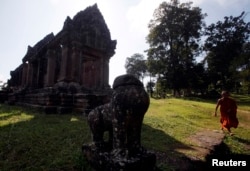Government officials in Thailand are seeking to soothe social media outrage in neighboring Cambodia over the heritage of a classical dance performed in both Southeast Asian nations.
Cambodia is also welcome to register the mask dance with UNESCO as an intangible cultural heritage, according to Thai deputy prime minister Wissanu Kreau-ngam.
Thailand, currently governed by a military junta, however, will plan to press ahead with its own UNESCO application, according to Culture Minister Weera Rojpojanarat, as UNESCO has no limit on how many countries can host similar heritage items.
Cambodia, Indonesia and Thailand share claims to shadow puppetry, while Argentina and Uruguay both have listed tango on the UNESCO list, noted the culture minister who also cited the rival Koreans sharing kimchi — a fermented side dish — as a registered cultural asset.
The mask dance issue
But Cambodians on social media have expressed alarm in recent days about Thailand’s plan to register the elaborate mask dance — known as Khon in Thai and Khol in Khmer (and Pra Lak Pra Ram in Lao) — arguing that it is part of Khmer heritage and the Thai version is a latecomer and imitator.
Cambodia’s culture ministry, on social media postings, sought to calm passions saying protesting Thailand’s claim “could damage relations between the two countries.”
An image asserting Cambodian sovereignty over the dance has been shared more than 10,000 times in the past three days on Facebook.
Hun Sen involved
Even Cambodia’s prime minister, Hun Sen, has stepped into the controversy with a Facebook posting rebutting the notion that his government did not care about the matter.
The mask dance dispute “is something that will increase nationalism in Cambodia. But it's also something which, in Thailand, is an attempt to embrace the Thai heritage,” said Paul Chamber, a law faculty lecturer at Chiang Mai University in northern Thailand. “Basically we have dueling nationalism alive and well in this controversy over this dance.”
Many historians regard the Southeast Asian dance as a regional variation of the epic Ramayana tale from ancient Hindu India.
Thailand, mask dance is different
Thailand is pushing for the Khon’s inclusion as it celebrates the completion of the sixth birth cycle (84 years) of Queen Sirikit, who is the kingdom’s patron of the mask dance.
“Thais would argue that these two dances are just a little bit different so they are not stealing from the Cambodians,” Chambers told VOA.
The Khmer empire, which peaked in the 11th to 13th centuries, dominated Southeast Asia and included much of what is modern-day Thailand.
Subsequent Siamese conquests had the Khmers paying tribute to Thailand until the French conquest of Indochina in the mid-19th century.
It is widely recounted that vanquished Khmer dancers were brought to the Thai royal court to perform after invasions of the Cambodian capitals (Angkor in 1431 and Phnom Penh in 1594).
In recent years Cambodia and Thailand were also at odds over the sovereignty over border land around an ancient Hindu temple, which is a UNESCO World Heritage site.
The dispute over the clifftop Preah Vihear, which led to artillery skirmishes and mobilization of military units on both sides in 2011, was settled when the International Court of Justice two years later ruled that land adjacent to the temple belonged to Cambodia and that Thai security forces should stay out of the area.










